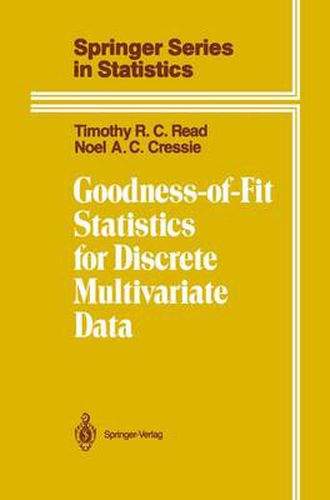Readings Newsletter
Become a Readings Member to make your shopping experience even easier.
Sign in or sign up for free!
You’re not far away from qualifying for FREE standard shipping within Australia
You’ve qualified for FREE standard shipping within Australia
The cart is loading…






This title is printed to order. This book may have been self-published. If so, we cannot guarantee the quality of the content. In the main most books will have gone through the editing process however some may not. We therefore suggest that you be aware of this before ordering this book. If in doubt check either the author or publisher’s details as we are unable to accept any returns unless they are faulty. Please contact us if you have any questions.
The statistical analysis of discrete multivariate data has received a great deal of attention in the statistics literature over the past two decades. The develop ment ofappropriate models is the common theme of books such as Cox (1970), Haberman (1974, 1978, 1979), Bishop et al. (1975), Gokhale and Kullback (1978), Upton (1978), Fienberg (1980), Plackett (1981), Agresti (1984), Goodman (1984), and Freeman (1987). The objective of our book differs from those listed above. Rather than concentrating on model building, our intention is to describe and assess the goodness-of-fit statistics used in the model verification part of the inference process. Those books that emphasize model development tend to assume that the model can be tested with one of the traditional goodness-of-fit tests 2 2 (e.g., Pearson’s X or the loglikelihood ratio G ) using a chi-squared critical value. However, it is well known that this can give a poor approximation in many circumstances. This book provides the reader with a unified analysis of the traditional goodness-of-fit tests, describing their behavior and relative merits as well as introducing some new test statistics. The power-divergence family of statistics (Cressie and Read, 1984) is used to link the traditional test statistics through a single real-valued parameter, and provides a way to consolidate and extend the current fragmented literature. As a by-product of our analysis, a new 2 2 statistic emerges between Pearson’s X and the loglikelihood ratio G that has some valuable properties.
$9.00 standard shipping within Australia
FREE standard shipping within Australia for orders over $100.00
Express & International shipping calculated at checkout
This title is printed to order. This book may have been self-published. If so, we cannot guarantee the quality of the content. In the main most books will have gone through the editing process however some may not. We therefore suggest that you be aware of this before ordering this book. If in doubt check either the author or publisher’s details as we are unable to accept any returns unless they are faulty. Please contact us if you have any questions.
The statistical analysis of discrete multivariate data has received a great deal of attention in the statistics literature over the past two decades. The develop ment ofappropriate models is the common theme of books such as Cox (1970), Haberman (1974, 1978, 1979), Bishop et al. (1975), Gokhale and Kullback (1978), Upton (1978), Fienberg (1980), Plackett (1981), Agresti (1984), Goodman (1984), and Freeman (1987). The objective of our book differs from those listed above. Rather than concentrating on model building, our intention is to describe and assess the goodness-of-fit statistics used in the model verification part of the inference process. Those books that emphasize model development tend to assume that the model can be tested with one of the traditional goodness-of-fit tests 2 2 (e.g., Pearson’s X or the loglikelihood ratio G ) using a chi-squared critical value. However, it is well known that this can give a poor approximation in many circumstances. This book provides the reader with a unified analysis of the traditional goodness-of-fit tests, describing their behavior and relative merits as well as introducing some new test statistics. The power-divergence family of statistics (Cressie and Read, 1984) is used to link the traditional test statistics through a single real-valued parameter, and provides a way to consolidate and extend the current fragmented literature. As a by-product of our analysis, a new 2 2 statistic emerges between Pearson’s X and the loglikelihood ratio G that has some valuable properties.